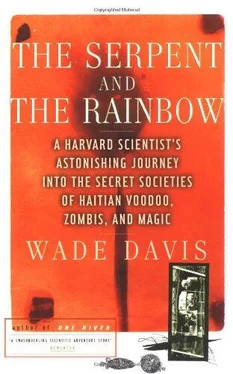Wade Davis - The Serpent and the Rainbow
Здесь есть возможность читать онлайн «Wade Davis - The Serpent and the Rainbow» весь текст электронной книги совершенно бесплатно (целиком полную версию без сокращений). В некоторых случаях можно слушать аудио, скачать через торрент в формате fb2 и присутствует краткое содержание. Год выпуска: 1985, Издательство: Simon & Schuster, Жанр: Старинная литература, на английском языке. Описание произведения, (предисловие) а так же отзывы посетителей доступны на портале библиотеки ЛибКат.
- Название:The Serpent and the Rainbow
- Автор:
- Издательство:Simon & Schuster
- Жанр:
- Год:1985
- ISBN:нет данных
- Рейтинг книги:5 / 5. Голосов: 1
-
Избранное:Добавить в избранное
- Отзывы:
-
Ваша оценка:
- 100
- 1
- 2
- 3
- 4
- 5
The Serpent and the Rainbow: краткое содержание, описание и аннотация
Предлагаем к чтению аннотацию, описание, краткое содержание или предисловие (зависит от того, что написал сам автор книги «The Serpent and the Rainbow»). Если вы не нашли необходимую информацию о книге — напишите в комментариях, мы постараемся отыскать её.
The Serpent and the Rainbow — читать онлайн бесплатно полную книгу (весь текст) целиком
Ниже представлен текст книги, разбитый по страницам. Система сохранения места последней прочитанной страницы, позволяет с удобством читать онлайн бесплатно книгу «The Serpent and the Rainbow», без необходимости каждый раз заново искать на чём Вы остановились. Поставьте закладку, и сможете в любой момент перейти на страницу, на которой закончили чтение.
Интервал:
Закладка:
This did not suggest that the zombi poison might be only a pleasant hallucinogen. But like the mushroom, its potential was latent. The Japanese victim lying conscious but paralyzed while his family mourned his death might, upon recovery, rationalize his terrifying experience within the expectations of his society. Everyone knows that is what fugu poisoning is like. Without doubt, in the phantasmagoric cultural landscape of Haiti, Clairvius Narcisse had his own expectations that he carried with him literally into and out of the grave. Of what was going on in his mind, I had no idea, and until I did I would know nothing about zombis. But I did have available to me—and the opportunity to explore it before my return to Haiti—a literature that would provide a context for understanding.
8
Voodoo Death
COUNT KARNICE-KARNICKI was a compassionate man, and his invention made him the rage of Europe. The count was a Russian nobleman, the chamberlain to the czar, but his inspiration had come in Belgium while attending the funeral of a young girl. As the first shovefuls of dirt landed on the wooden coffin, a pitiful scream rose from the earth, staggering the officiating priest and causing a number of young women to faint. It was a sound that the count would never forget. He, like so many of his generation in all corners of Victorian Europe, became obsessed by the threat of premature burial.
His invention, introduced just before the turn of the century, was a simple contraption, efficient and inexpensive enough to be well within reach of rich and poor alike. For the truly destitute, the apparatus was available for rent. It consisted of a hermetically sealed box and a long tube that would be fixed into an aperture in the coffin as soon as it was lowered into the ground. On the chest of the dead person was placed a large glass ball attached to a spring linked to the sealed box. With the slightest movement of the glass ball, as would occur if breathing began, the spring would be released, causing the lid of the box to fly open and admit both light and air to the buried coffin. At the same time the spring initiated a mechanical chain reaction worthy of Rube Goldberg. A flag sprang four feet above the box, a bell began to ring and continued for thirty minutes, and an electric lamp ignited. The long tube was envisioned not only to admit oxygen, but also to serve as a megaphone, amplifying the presumably weak voice of the almost dead. Not a hundred years ago, at the turn of this century, this peculiar apparatus was heralded as a technological breakthrough. Many thousands of Frenchmen left specific instructions in their wills to ensure that it would be placed on their tombs. In the United States it was so popular that societies formed to promote its subsidized use.
The citizens who embraced Count Karnice-Karnicki’s invention were responding to an epidemic of premature burials that had colored the popular press and confounded medical authorities. A typical report appeared in the London Echo in March of 1896. Nicephorus Glycas, the Greek Orthodox metropolitan of Lesbos, was pronounced dead in his eightieth year. According to the traditions of his church he was immediately garbed in his episcopal vestments and placed on a throne, where his body was exposed day and night to the faithful, and guarded constantly by priests. On the second night, the old man suddenly awoke and stared with amazement and horror at the parade of mourners at his feet. His priests, according to the report, were no less startled to realize that their leader had not been dead but had merely fallen into a deathlike trance. The Echo correspondent impassionately questioned what might have happened had the metropolitan been a layman, and then concluded that he would have been buried alive.
A second popular account was that of a Reverend Schwartz, an Oriental missionary who was reportedly aroused from apparent death by his favorite hymn. The congregation celebrating his last rites was stunned to hear a voice from the coffin joining in on the refrain.
Though today both of these cases may appear preposterous, at the time they were not only seriously discussed, they were believed, and they helped fuel a hysterical fear of premature burial that swept late Victorian Europe. In 1905 an English physician and member of the Royal College of Surgeons edited a volume in which were documented 219 narrow escapes from premature burial, as well as 149 cases in which the body was actually interred while still alive. Also noted were ten instances in which autopsies were erroneously performed on the living, and two cases in which consciousness returned to the “corpse” during the process of embalming.
Many people were not about to take any chances. Hans Christian Andersen constantly carried a note in his pocket instructing what should be done with his body in the event of his death. The English novelist Wilkie Collins placed a similar precautionary note by his bedside table each night. So did Dostoyevsky, who urged that his burial be delayed five days lest his apparent death be but a trance. Certain leading members of the British aristocracy took more drastic measures, which incidentally were remarkably similar to certain Haitian practices that their countrymen would no doubt have condemned. The vodounist, fearing that a family member will be raised as a zombi, has been reported to drive a blade through the heart of the dead. Fearing premature burial, the noted British antiquary Francis Douce requested in his will that the surgeon Sir Anthony Carlisle be permitted to sever his head from his body. So did a certain Harriet Martineau. A well-known actress of the era, Ada Cavendish, left instructions in her will that her jugular be sliced. Lady Burton, widow of the famous African explorer and writer Sir Richard Burton, provided that her heart be pierced with a needle. Bishop Berkeley, Daniel O’Connell, and Lord Lytton had similar fears and ordered that their burials be delayed, and that one or more of their veins be opened so that their blood would drain and thus assure that they were truly dead.
By the turn of this century fear of premature burial had grown into an overriding public concern. It was discussed in all the learned medical journals, and in England it generated parliamentary inquiries that led to the Burial Act of 1900, which among its many statutes specified the length of time that had to transpire between the pronouncement of death and actual interment. On the Continent prizes were offered for the discovery of a conclusive sign of death. In France in 1890 a certain Dr. Maze was awarded the prestigious Prix Dusgate and twenty-five hundred francs simply for asserting that the only reliable sign of death was putrefaction. The earnest scientific interest in establishing the difference between real and apparent death is evident in an academic textbook on the subject published in 1890 whose bibliography lists no fewer than 418 citations.
Actually, a satisfactory means of diagnosing death has both obsessed and eluded man since earliest times. Of course the fundamental signs of death have always been known, and they have not changed. They are: cessation of respiration and heartbeat, changes in the eye, insensibility, rigor mortis, pallor and discoloration due to the settling of the blood. The problem, as Kline had expressed so forcefully when we first met, has always been that not one of these is foolproof. And once that is recognized and admitted, a floodgate of possibilities opens.
But there was something else going on in the minds of Victorian society. Just how serious a threat premature burial was in the late nineteenth century is uncertain. Even at the time many insisted that reports were greatly exaggerated. Yet the very fact that the debate flourished in the Houses of Parliament and the halls of the Royal Academy was as significant as its outcome. An already uneasy public undoubtedly took note that the subject was being seriously considered within institutions that were the very pillars of the Victorian world and, by extension, of reason itself. As physicians outlined the difficulties of diagnosing death, politicians debated how long the dead should be kept from the grave, and salesmen pitched Count Karnice-Karnicki’s invention, the public mood was further aroused by certain popular accounts. One of these was the notorious case of a Colonel Townsend. According to a panel of physicians called upon to witness the event, this officer willingly reduced his heart rate and entered a self-induced trance, or, as some described it, a state of suspended animation. Heartbeat ceased, respiration stopped, and the entire body assumed the icy chill and rigidity of death. The color fled from Townsend’s face; his eyes became glazed and fixed. After he had been comatose for thirty minutes, the physicians actually certified him dead and prepared to go home. As they did so, Townsend began to recover slowly, and by the next day he was well enough to repeat his feat. This case was widely quoted not only in the press but in academic textbooks of medical jurisprudence, and it undoubtedly lent credence to contemporary statements such as “the difference between trance and death has never been quite understood by the majority of mankind.”
Читать дальшеИнтервал:
Закладка:
Похожие книги на «The Serpent and the Rainbow»
Представляем Вашему вниманию похожие книги на «The Serpent and the Rainbow» списком для выбора. Мы отобрали схожую по названию и смыслу литературу в надежде предоставить читателям больше вариантов отыскать новые, интересные, ещё непрочитанные произведения.
Обсуждение, отзывы о книге «The Serpent and the Rainbow» и просто собственные мнения читателей. Оставьте ваши комментарии, напишите, что Вы думаете о произведении, его смысле или главных героях. Укажите что конкретно понравилось, а что нет, и почему Вы так считаете.












